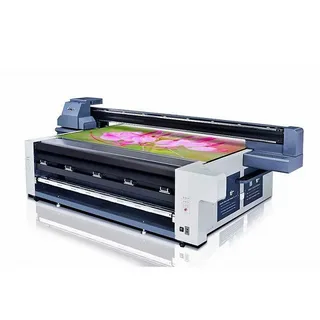According to Future Market Insights, the hybrid printing market is poised for significant growth, with its size expected to increase from US$ 5.6 billion in 2024 to US$ 19.2 billion by 2034. Over the next decade, an impressive 13.2% CAGR in the demand for hybrid printings is projected to drive the expansion, which had seen a CAGR of 16.3% between 2019 and 2023.
Increased demand for customized printing solutions is one key driver. Consumers are seeking unique and personalized printing outputs to stand out in a competitive market. In addition to providing versatility in terms of style and content, hybrid printers enable the effective creation of customized materials, satisfying this expanding demand.
The ability of hybrid printers to combine the benefits of both digital and traditional printing methods is attracting businesses looking for versatile options. Hybrid printers combine the quality and adaptability of conventional printing techniques, such as offset printing, with the rapid turnaround times and economic output typical of digital printing.
Request for a Sample of this Research Report
The hybrid printing market is experiencing a surge in demand as it merges 3D printing capabilities with conventional techniques. This integration allows for more complex and customizable manufacturing processes, driving interest across various industries. As a result, businesses are embracing hybrid printing to streamline production and meet evolving consumer demands effectively.
“The ascent of developing nations as strong players in the hybrid printing market presents a notable challenge to the established dominance of developed nations. Developing nations are making significant investments in infrastructure and technology in order to compete in and access new markets. Furthermore, these nations now find it easier to cooperate with foreign partners and access global markets because of developments in communication and transportation.” according to the chief analyst at FMI.
Key Takeaways
- The United States is set to dominate the hybrid printing industry with a projected 13.4% CAGR from 2024 to 2034, driven by a robust ecosystem of research and development in addition to a demand for personalized manufacturing solutions.
- China’s hybrid printing industry is projected to follow closely, with an estimated 13.6% CAGR through 2034, attributed to its substantial investment in research and development as well as burgeoning manufacturing infrastructure.
- Japan’s hybrid printing market is projected to develop at a 13.8% CAGR through 2034, propelled by its long-standing reputation for technological innovation and a culture that values precision and quality in manufacturing.
- The South Korea hybrid printing industry is likely to exhibit a 14.8% CAGR from 2024 to 2034, impacted by its robust manufacturing sector and strong government support for technological innovation.
- The hybrid printing industry in the United Kingdom is likely to show a 14.5% CAGR between 2024 and 2034, influenced by a highly skilled workforce in addition to a prospering ecosystem of innovative startups and established companies.
Key Players’ Strategies for Success in the Hybrid Printing Market
Here are some key strategies that players in the hybrid printing industry employ for success:
- Continuous innovation in technology and processes
- Strategic partnerships with suppliers and clients
- Emphasis on sustainability and eco-friendly practices
- Diversification of product offerings and services
- Providing Customization and personalization options
- Effective marketing and branding strategies
- Maintaining strong customer relationships and satisfaction
- Collaboration with other industries for cross-promotion
Recent Developments
- Voltera confirmed the release of NOVA, a fresh platform for printing flexible hybrid electronics, in November 2022. It prints circuits on pliable, elastic, and conformable surfaces using direct write technology.
- Adelco unveiled the new Adelco Hybrid Digital System in September 2022. It is a high-speed textile printer that integrates smoothly with their automated screen printing presses.
Key Segments
By Technology:
- UV Inkjet Printing
- Water Based Printing
- Solvent Printing
- LED Curable
- Dye Sublimation
By Application:
- Label Printing
- Packaging Printing
- Commercial Printing
- Others
By End-use Industry:
- Healthcare
- Food and Beverage
- Consumer Goods
- Others
By Region:
- North America
- Latin America
- Europe
- East Asia
- South Asia & Pacific
- Middle East & Africa (MEA)
Click to Buy Your Exclusive Report Immediately!
About Future Market Insights (FMI)
Future Market Insights, Inc. (ESOMAR certified, recipient of the Stevie Award, and a member of the Greater New York Chamber of Commerce) offers profound insights into the driving factors that are boosting demand in the market. FMI stands as the leading global provider of market intelligence, advisory services, consulting, and events for the Packaging, Food and Beverage, Consumer Technology, Healthcare, Industrial, and Chemicals markets. With a vast team of over 400 analysts worldwide, FMI provides global, regional, and local expertise on diverse domains and industry trends across more than 110 countries. Join us as we commemorate 10 years of delivering trusted market insights. Reflecting on a decade of achievements, we continue to lead with integrity, innovation, and expertise.
Contact Us:
Future Market Insights Inc.
Christiana Corporate, 200 Continental Drive,
Suite 401, Newark, Delaware – 19713, USA
T: +1-845-579-5705
For Sales Enquiries: sales@futuremarketinsights.com
Website: https://www.futuremarketinsights.com
LinkedIn| Twitter| Blogs | YouTube

